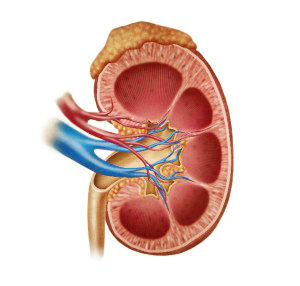There are two main types of hyperparathyroidism, primary hyperparathyroidism and secondary hyperparathyroidism. The term “hyperparathyroidism” generally refers to primary hyperparathyroidism.
Primary Hyperparathyroidism
 Primary hyperparathyroidism is most commonly caused by one or more of the parathyroid glands forming a tumor that secretes excessive parathyroid hormone. Over 95% of these tumors are benign. Over 80% of the time this is from a single enlarged parathyroid gland. This enlarged parathyroid gland tumor is called a parathyroid adenoma. Primary hyperparathyroidism is rarely caused by parathyroid cancer. Normal parathyroid glands stop secreting parathyroid hormone(PTH) in response to normal or elevated calcium levels in the blood. The abnormal parathyroid adenoma does not “turn-off” in response to a normal or elevated calcium level in the blood stream and therefore continues to secrete PTH. This in turn causes an elevated calcium level in the blood stream.
Primary hyperparathyroidism is most commonly caused by one or more of the parathyroid glands forming a tumor that secretes excessive parathyroid hormone. Over 95% of these tumors are benign. Over 80% of the time this is from a single enlarged parathyroid gland. This enlarged parathyroid gland tumor is called a parathyroid adenoma. Primary hyperparathyroidism is rarely caused by parathyroid cancer. Normal parathyroid glands stop secreting parathyroid hormone(PTH) in response to normal or elevated calcium levels in the blood. The abnormal parathyroid adenoma does not “turn-off” in response to a normal or elevated calcium level in the blood stream and therefore continues to secrete PTH. This in turn causes an elevated calcium level in the blood stream.
The diagnosis of hyperparathyroidism is made when there is an elevated blood calcium level together with an elevated or high-normal PTH. In almost all cases, surgery is recommended to remove the abnormal parathyroid adenoma. There is no medication or treatment to cure primary hyperparathyroidism.
Secondary Hyperparathyroidism
 Secondary hyperparathyroidism is caused by medical conditions that cause low blood calcium levels. In response to this low calcium level, the parathyroid glands react and produce PTH. The PTH is elevated beyond the normal limits because the body is trying to increase the calcium levels in the blood stream. Conditions that cause secondary hyperparthyroidism include Vitamin D deficiency, calcium deficiency and chronic kidney disease (when Vitamin D is not effectively converted to its active form by the kidneys).
Secondary hyperparathyroidism is caused by medical conditions that cause low blood calcium levels. In response to this low calcium level, the parathyroid glands react and produce PTH. The PTH is elevated beyond the normal limits because the body is trying to increase the calcium levels in the blood stream. Conditions that cause secondary hyperparthyroidism include Vitamin D deficiency, calcium deficiency and chronic kidney disease (when Vitamin D is not effectively converted to its active form by the kidneys).
Treatment for secondary hyperparathyroidism is focused on correcting the underlying cause of the low calcium levels. This usually includes Vitamin D and calcium supplements. Surgery is sometimes recommended, although not as often as with primary hyperparathyroidism.


